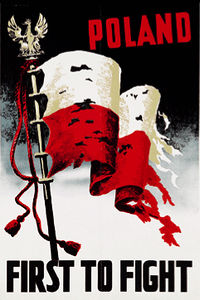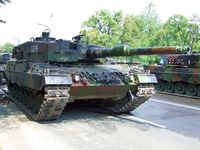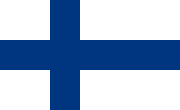Polish Armed Forces
| Armed Forces of Republic of Poland 'Siły Zbrojne Rzeczypospolitej Polskiej' |
|
|---|---|
    |
|
| Service branches | Polish Land Forces Polish Air Force Polish Navy Polish Special Forces |
| Leadership | |
| Commander-in-Chief | Bronisław Komorowski (Acting President of Poland) |
| Minister of Defense | Bogdan Klich |
| Manpower | |
| Military age | 18 years of age |
| Conscription | No |
| Available for military service |
10,354,978, age 15–49 (2003 est.) |
| Reaching military age annually |
343,500 (2003 est.) |
| Active personnel | 100,272 |
| Reserve personnel | 240,000 |
| Expenditures | |
| Budget | $11.8 billion (FY2009) 19th |
| Percent of GDP | 1.95% (FY2008) |
| Related articles | |
| History | List of Polish wars Timeline of the Polish Army |
Siły Zbrojne Rzeczypospolitej Polskiej ("Armed Forces of the Polish Republic", abbreviated SZ RP; popularly, Wojsko Polskie, abbreviated WP—roughly, the "Polish Military") are the national defense forces of Poland. The name has been used since the early 19th century, but can also be applied to earlier periods.
The Polish Armed Forces comprise the Army (Wojska Lądowe), Navy (Marynarka Wojenna), Air Force (Siły Powietrzne) and Special Forces (Wojska Specjalne) and are under the command of the Ministry of National Defense (Ministerstwo Obrony Narodowej).
Contents |
History

Main articles: History of the Polish Army, Armia Krajowa (Army of the Country), Polish contribution to World War II.
The modern day "Wojsko" was created in 1918, from the three separate Russian, Austro-Hungarian, and Prussian armies and equipment left following World War I. The force expanded during the Polish-Soviet War of 1919–1922 to nearly 800,000 men, but then was reduced when peace was reestablished. During the Second World War, on September 1, 1939 the force was nearly one million men strong, but was overwhelmed by a German attack in September 1939, which was followed on September 17, 1939 by a Soviet attack (see: Polish September Campaign).
Some Polish forces escaped from their occupied, divided country, and joined Allied forces fighting in other theatres while those that remained in Poland splintered into guerilla units of the Home Army and partisan groups which fought in clandestine ways against the foreign occupiers of Poland.
After the war, the Soviet Union imposed their own structure on the armed forces and created the "People's Army of Poland" : Siły Zbrojne Rzeczypospolitej Polskiej (1945–1952) , Siły Zbrojne Polskiej Rzeczypospolitej Ludowej (Armed Forces of People's Republic of Poland) (1952–1990) . This was ultimately discarded after the fall of communism. Currently the armed forces is being re-organized according to NATO standards. As of 1 January 2010, the Armed Forces of the Republic of Poland have transitioned to a completely contract-based army.
On April 10, 2010 Polish Armed Forces lost six from out of seven top military commanders in an aviation crash near Smolensk Russia; the President (Commander-in-Chief), all four Branch Commanders and the Chief of Staff. The Minister of Defence was not on board and remains in office. Other high-ranking military officers and chaplains were amongst the victims.
Organization





The Polish armed forces consists of 100,300[1] active duty personnel and in addition 234,000 reserves. In 2009 the Armed Forces transformed into a fully professional organization and compulsory military service was abolished. Troop strength in the different branches is as followed (2009):
- Land Forces: 60,000 (3 divisions, independent units and territorial forces)
- Air Force: 26,000 (Air and Air Defense Corps)[2]
- Navy: 14,000 (2 Fleets)[2]
- Special Forces: 1,700 (4 Special Units - GROM, 1 PSK, "Formoza", special logistics Military Unit)[2]
- Military Police or Żandarmeria Wojskowa (in Polish).
In addition the 100,000+ active personnel will get reinforced by the newly created Military reserve forces, these will consist of an additional 20,000 troops.[3]
Equipment
Land Forces
- Main Battle Tanks: 906 (Leopard 2A4, PT-91, PT-91M, PT-91MA1, T-72, T-72A, T-72M1, T-72M1D)[4]
- AFV: 1687 (KTO Rosomak, BWP-1, BWR-1S, BWR-1D, HMMWV, BRDM-2)[4]
- Artillery: 1153 (120mm or greater)[4]
- Army Helicopters: 143 (PZL W-3, PZL SW-4, Mi-8, Mi-17, Mi-24, Mi-2 )[4]
Air Force
- Jet Fighter: 83 ( 35 MiG-29A, 48 F-16 C,D block 52+)[4]
- Attack Aircraft: 45 (Su-22M4)[4]
- Jet Trainer Aircraft: 54 (PZL TS-11 Iskra)[4]
- Turboprop Trainer Aircraft: 37 (PZL-130 Orlik)[4]
- Cargo aircraft: 40 (C-295, C-130, PZL M28)[4]
- Helicopters: 58 (PZL W-3, PZL SW-4, Mi-8, Mi-17, Mi-2, Bell 412)[4]
- Frigates: 2 (Oliver Hazard Perry Class)[4]
- Corvettes: 3 (Kaszub class, Tarantul Class)[4]
- Submarines: 5 (Kilo Class, Kobben Class)[4]
- Fast Attack Craft: 3 (Orkan Class)[4]
- Mine Counter-Measure Vessels: 19 (Gardno class, Mamry class, 206FM class)[4]
- Minelayer-Landing crafts: 5 (Lublin class)[4]
- Over 40 other vessels (including survey ships, tankers, rescue and salvage and training ships)[4]
- Aircraft: 12 (PZL M28B Bryza)[4]
- Helicopter: 30 (Kaman SH-2, PZL W-3, Mil Mi-14, PZL Mi-2, Mil Mi-17)[4]
Modernization
The Polish military is in the middle of a long term modernization programme. It has acquired already; Tanks, frigates, submarines, helicopters, transport and fighter aircrafts as well as other modern weapon-systems. Immediate plans involve new AA Missile Systems, LIFT-advanced jet trainers, an aerial refueling aircraft, VIP transport aircraft, attack helicopters a submarine and self-propelled howitzers. However predictions suggest that the budget might not cope with the need of replacing its quick ageing equipment such as; Navy Vessels, Land Forces Artillery and Air Defence capacities since several programs have been already postponed or completely cancelled. Recent and ongoing modernization projects include:
 WR-40 Langusta for Rocket artillery (62 ordered + additional purchase option)
WR-40 Langusta for Rocket artillery (62 ordered + additional purchase option) KTO Rosomak for the Land Forces (895)
KTO Rosomak for the Land Forces (895) Gawron-class corvettes for the Navy (1 being build + 6 planned)
Gawron-class corvettes for the Navy (1 being build + 6 planned) Lockheed C-130 for the Air Force (5)
Lockheed C-130 for the Air Force (5) Projekt TYTAN Polish Future Soldier project.
Projekt TYTAN Polish Future Soldier project. Aeronautics Orbiter and Aerostar UAVs for the Special Forces (8 +)
Aeronautics Orbiter and Aerostar UAVs for the Special Forces (8 +)
Mission
.jpg)
The most basic goal of the armed forces is the defense of Polish territorial integrity, and Polish interests abroad. Poland's national security goal is to further integrate with NATO and other west European defense, economic, and political institutions via a modernization and reorganization of its military. Polish military doctrine reflects the same defense nature as its NATO partners. Poland continues to be a regional leader in support and participation in the NATO Partnership for Peace Program and has actively engaged most of its neighbors and other regional actors to build stable foundations for future European security arrangements. Poland is also playing an increasingly larger role as a major European peacekeeping power in the world through various UN peacekeeping actions, cooperating with neighbouring nations (LITPOLBAT, POLUKRBAT).
Recent operations
Polish Armed Forces took part in the 2003 invasion of Iraq, deploying 2,500 soldiers in the south of that country and commanding the 17-nation Multinational force in Iraq. In addition to this, Polish soldiers are currently deployed in five separate UN Peacekeeping Operations (UNDOF, UNIFIL, EUFOR and KFOR). Total international deployment of Polish military is over 4,800 troops.
Current deployment
|
Completed operations |
Miscellany
Polish Armed Forces are the only military entity in the world to use a two-finger salute which is only used while wearing a hat (it refers to the fact that the salute is given to the emblem itself) with the emblem of the Polish eagle, such as military hat rogatywka. The salute is performed with the middle and index fingers extended and touching each other, while the ring and little fingers are bent and touched by the thumb. The tips of the middle and index fingers touch the peak of the cap, two fingers supposedly meaning honour and fatherland (Honor i Ojczyzna).
See also
- Czesław Piątas, one-time Chief of General Staff of the Polish Army
- History of Polish Intelligence Services
- List of Polish wars
- Polish Army oaths
- Polish military awards and decorations
- Polish Armed Forces rank insignia
- Podhale rifles
- Polish Army Museum
- List of Polish armoured fighting vehicles
- Polish military eagle
Notes
- ↑ Polish Military personnel
- ↑ 2.0 2.1 2.2 http://www.biuletyn.mon.gov.pl/pliki/File/Dz_Urz_MON/2009pdf/Dz%20U%20MON%20Nr%201a%2009.pdf
- ↑ Rewolucja w polskiej armii- Onet.pl - Wiadomości -21.03.2009
- ↑ 4.00 4.01 4.02 4.03 4.04 4.05 4.06 4.07 4.08 4.09 4.10 4.11 4.12 4.13 4.14 4.15 4.16 4.17 4.18 :: Ministerstwo Obrony Narodowej - serwis internetowy :: Uzbrojenie ::
External links
- Polish Army Galleries
- Official Website of the Polish Land Forces
- Official Website of the Polish Ministry of Defense
- Official Website of the Polish Air Force
- Official Website of the Polish Navy
- Official website of the Polish Special Forces
- kamouflage.net > Europe > Poland (Republic of Poland)
- Pictures from Iraq of Polish Army
|
||||||||||||||||
|
|||||||
|
||||||||||||||
|
|||||